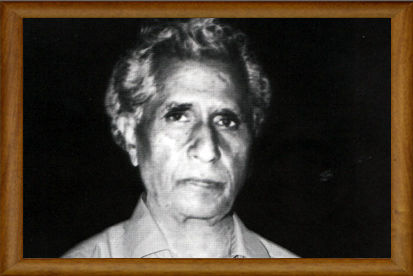Now here is a classic case of a person who kept rubbishing people left right and centre, and perhaps kept paying the price for it.
Talat Mahmood was 'Ghalat Mahmood' to Sajjad saab,
Naushad's name don't even mention in his presence, and in fact just about the entire music industry was full of people who did not deserve their honour, so thought Sajjad. No one except
Lata and Noorjahan , and from their songs, really speaking, only these were really good: Lata's 'Aye Dilruba Nazren Mila...' from 'Rustam Sohrab' and Noorjahan's 'Badnaam Mohabbat kaun Kare..' from Dost. Of course you do not get two chances for guessing who composed the above two songs.
He was so sensitive that if someone spelt his 'Husain' with two esses (or emphasized the 'seen' in Urdu), the maestro would get upset. If only Sajjad had channeled his considerable energies and talents into music-making (rather than on people bashing), why, he would have given music in more that the 14 movies to his credit. Not just that, history could have placed him on a higher pedestal.
Sajjad was born at Sitamau in M.P., in 1917. He was born into music atmosphere, since his father Mohd. Amir Khan was a sitar virtuoso in his time. Sajaad and his four brothers were put into Sitar training, but only Sajjad took to the instrument like a fish takes to water. After two years, Sajjad got to understand other instruments. and they all took to him! Flute, piano, Jal tarang, banjo, violin, clarinet, accordian, mandolin, harp, veena, the spanish and Hawaiian guitars. People spoke of him not as a musician, but an entire orchestra. But heloved the mandolin the most, and guess what? He later had five sons, all of whom could play the mandolin and as such they became busy with playing musical instruments professionally!
Sajjad came to Bombay to look for work in films in 1940, when there were creative composers like
Anil Biswas,
Khemchand Prakash,
Saraswati Devi and Jhande Khan. In Bombay he was discovered by Pandit Hanuman Prasad, the composer who would also discover
Geeta Roy later. The two together gave music in the film Gaali, in 1944. But soon Sajjad was on his own, scoring music for Dost, where there were many songs rendered by Noorjahan, including the above mentioned 'Badnaam Mohabbat Kaun Kare...', as well as ' Koi Prem Ka Deke Sandesa...'. But inspite of such a musical hit, he did not do too much popular work in the films that followed. The odd beautiful song would be there of course, as in Khel (1950) in which he made
Lata Mangeshkar sing this lilting composition: 'Bhool Ja Aye Dil...'. Later in 1952 was released Sangdil where he created great melody. Be it: 'Dharti se door gore badalon...', or 'Ye hawa ye raat ye chandni...', or 'Wo to chale gaye...', or 'Dil mein sama gaye saajan...' , or 'Kahan ho kahan mere jeewan sahare...' every song was a gem.
When you hear Sajjad's tunes and arrangements of instruments like in 'Kahan ho Kahan ...' above, specially how the song ends on th up, you get amazed at the difference between his style and of others. Difference without losing the appeal. Also his use of the counter-melody, common in western melodies, where one or two instruments seem to 'wander' from the theme, in the background. Notice how well he did this in 'Dil mein sama gaye saajan ...' too. But also just think how beautiful is the start of "Ye hawa ye raat ye chandni..', with the sitar and sarangi introducing, so to speak, the coming words.
And yet, even after Sangdil in 1952, nothing memorable came from Sajjad Husain. Then in 1962 came his swan-song, Rustom Sohrab, wherein he also introduced Iranian instruments in the film. He composed some very fine tunes too. This was rendered by
Lata Mangeshkar 'Aye Dilruba Nazrein mila..'. What a persian mood did Sajjad create here! And
Talat sang - 'Mazandaraan, Mazandaraan..'. While Suraiyya 'Ye kaisi ajab daastan ho gayi hai...'. And this one from
Rafi,
Manna Dey, Saadat, and chorus: 'Phir tumhari yaad aayee aye sanam...'
Here is a list Sajjad Hussain's 14 films:
1944: Gaali
1945: Dost & Dharam
1946: 1857 & Tilasmi Duniya
1947: Qasam & Mere Bhagwan
1950: Khel & Maghroor
1951: Hulchul & Saiyyan
1952: Sangdil
1955: Rukhsana
1963: Rustom Sohrab
Sajjad lived at Mahim, Bombay. In his last years, Sajjad shunned people completely, even barely stepping out of his home. No interviews for him, not even for radio. On 21st July 1995, Sajjad took his last breath. He was 78 then. Here was than man who played the difficult 'meend' on the mandolin - of all musical instruments, in front of a who's who of music at Calcutta in 1956, electrifying them. Who were these luminaries? Usrad Alluddin Khan, Bade Ghulam Ali Kha, Ahmedjaan Thirakwa, Nikhil Banerjee,
Ali Alkbar Khan, and Pt. Vinayak Rao.
The man who had provided that electricity was now without a spark himself. His time had come and gone. With a small body of good songs.
Contributed by: Mr. Manek Premchand
Author: Yesterday's Melodies Today's Memories

